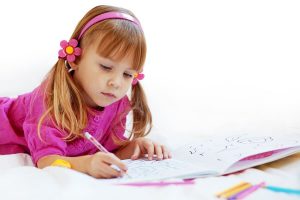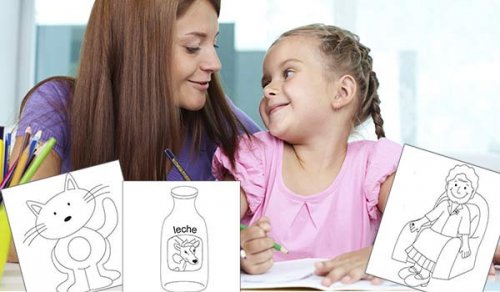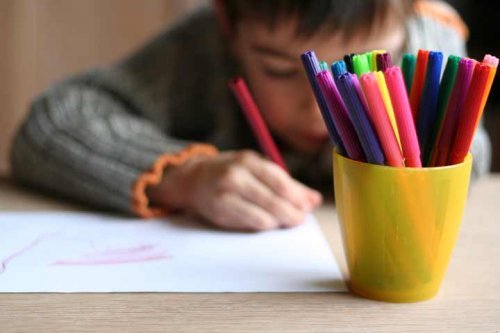The Benefits of Coloring for Children

Coloring has always been a fundamental activity when it comes to child development. Many consider coloring to be a simple pass time, but it’s actually so much more than that. There are a number of benefits of coloring that children can enjoy.
That being said, in this technological age, tablets and smartphones are starting to replace coloring. Therefore, it’s very important to motivate children to color during their free time. It’s a highly beneficial activity for their mental and psychological development.
The benefits of coloring for children
The habits of coloring and painting are, without a doubt, highly enriching for children. It’s a way for children to understand the world around them and a means to communicate freely. Coloring is a fun activity that contributes a great deal to a child’s infancy.
Among the main benefits of coloring are the following:
Coloring improves children’s motor skills
Coloring is an excellent exercise for improving fine motor development in children. It’s a way to strengthen the brain circuits that have to do with this ability. Coloring also allows children to develop hand-eye coordination.
Boosts self-esteem
Coloring is a source of happiness and satisfaction for children when it occurs in a non-competitive context. This helps boost their self-esteem.
Most children interpret their artistic creations as accomplishments. They feel capable and proud of their masterpieces. This feeling is even stronger when they receive the praise of their family members.

Coloring develops creativity in children and communication with their environment
When talking about the benefits of learning to color, it’s important to mention creativity. Coloring both stimulates and develops creativity in children.
In general, children don’t have established patterns or references. When they sit down to color, they feel free to create without parameters that condition them.
This activity is also a tool through which children learn to express themselves and communicate with their peers. From children’s drawings, adults can glean a great deal of information about what their children think and experience.
Coloring improves the development of learning
Children who color develop a more active role in their learning process. In other words, they learn more and in a more efficient way.
But that’s not all. Coloring helps children better understand the world, and makes them more motivated to learn.
“Coloring is a way to strengthen the brain circuits that have to do with this ability. Coloring also allows children to develop hand-eye coordination.”
Coloring encourages self-control and concentration
Coloring is a highly practical strategy for stimulating concentration in children. It provides the perfect stimulus for selective attention when children are small.
At the same time, this method helps boosts emotional self-control. It’s the means through which children channel their emotions when they’re happy, sad or excited.

How to motivate children to color
As we stated above, technological advances affect the lives of everyone. Because of their access to digital activities, children today often dedicate less time to activities that are vital to their development, like drawing and coloring. For that reason, motivating children and teaching them to color is more important than ever.
There are many ways to motivate children. One of the most important is for parents to share time with their kids during this activity. If children have the chance to create freely and spend time with their parents as well, coloring becomes even more appealing.
Another way to motivate little ones is to set up an art area within your home. Create a space where they can access different materials and lots of colors: Paper, canvases, pencils, paints, etc. Keep in mind that the variety of materials will boost your child’s creativity beyond limits.
Lastly, we also recommend signing children up for art classes or taking them to see different exhibits. Exposing children to the works of other artists can be very interesting for them. Many museums offer guided tours especially for children that include workshops and games.
All cited sources were thoroughly reviewed by our team to ensure their quality, reliability, currency, and validity. The bibliography of this article was considered reliable and of academic or scientific accuracy.
- Goodnow, J. (1979). El dibujo infantil (Vol. 8). Ediciones Morata.
- Muños-Hidalgo, M. D. (2014). El dibujo infantil: La etapa preesquemática. http://tauja.ujaen.es/bitstream/10953.1/796/4/TFG_MuñozHidalgo%2cMar%C3%ADaDolores.pdf
- Lowenfeld, V. & Brittain, W. L. (1980). Desarrollo de la capacidad creadora (2a Ed.). Buenos Aires: Kapelusz.
- Cordera, M., Bertolez, A., Monesterolo, L., & Herrera, M. El dibujo infantil como expresión de desarrollo saludable.
- Acaso, M. (2000). Simbolización, expresión y creatividad: tres propuestas sobre la necesidad de desarrollar la expresión plástica infantil. Arte, individuo y sociedad, (12), 41. https://revistas.ucm.es/index.php/ARIS/article/download/ARIS0000110041A/5919
- Cándano, S. (2013). La pintura beneficiosa para el desarrollo de los niños. http://www.ampaikasbide.com/downloads/pintura/Desarrollo%20y%20aprendizaje.pdf
This text is provided for informational purposes only and does not replace consultation with a professional. If in doubt, consult your specialist.








